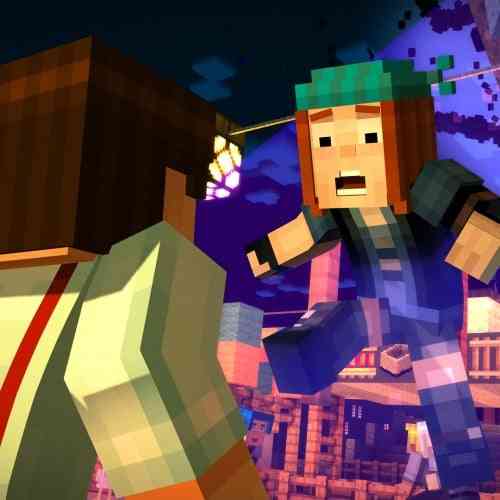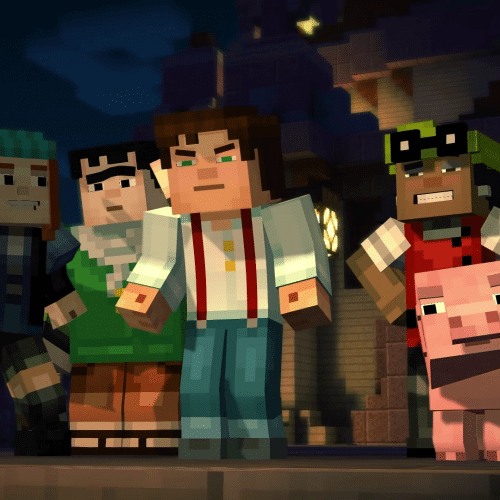Telltale Games has built a business on filling a much-needed niche in video games: strong narrative experiences. Although the company has a long development history, it was really 2012’s The Walking Dead that established Telltale as the industry standard in episodic storytelling in gaming. Since then, they have cemented that reputation with follow-ups that include Game of Thrones and Tales From the Borderlands.
Now comes Minecraft: Story Mode. Combining the trademark Telltale gameplay with the massively-popular Minecraft franchise, Minecraft: Story Mode brings life to the open-world sandbox that has captivated millions of players, and made Markus “Notch” Persson the wealthy (but apparently unhappy) person he is. After playing through the first episode, I can tell you that Minecraft: Story Mode is a decent start that brings a beautiful, polished experience, but lacks the narrative depth that many players will be expecting.
First, let’s talk about the game’s strengths. While Telltale might be known for its narrative skills, it’s actually in the technical polish that I think the company is underrated. Minecraft: Story Mode continues Telltale’s high standard for graphical quality, with gorgeous visuals that are always pleasant to look at. While previous Telltale games employed a cel-shaded graphic novel style, Minecraft: Story Mode sticks close to its source material, and uses the same blocky retro look as Minecraft. This is not at all a downside visually; if anything, I loved that the game copies its source’s look. I personally love the look of Minecraft – it is so rich in color, and so full of interesting things, that despite being blocky it is never chore on the eyes. Telltale made the wise choice not to try and fix what wasn’t broke.
_____________________________
“Thus, the story in Minecraft: Story Mode is a bit flat, and while it certainly does the job well enough to keep you playing, it is not very memorable (at least so far in Episode 1).”
Another very refined aspect of Minecraft: Story Mode is the gameplay. Telltale has had a lot of practice in refining their quick time events-based style, and in this latest game, it works well. For action events, you use your X, square, triangle, and circle buttons in various ways to respond to contextual prompts. Timing can be a factor, although I found in Episode 1 that I was never taxed very much in pressing the right button in time. You also seem to have some cues that work to telegraph the fact that you will soon need to “do things” rather than just passively watch. You learn to anticipate when these action-times will be, and when you can go back to relaxing. The responsiveness of the action gameplay was spot-on, in my experience, and I never failed due to any lag between my button pressing and the character’s reactions.
In voice acting, Minecraft: Story Mode is perhaps one of the standouts among all the games I have ever played. Two voices in particular, Patton Oswalt as the male main character, and Brian Posehn as Axel, were amazing and really added to the immersion of the story. It also helped that Telltale has perfected the timing of the character’s mouth and facial expressions, so that there was no uncanny valley of awkwardness to mar the experience. Music and sound effects also contributed to an overall level of polish in the production values that you will not see often in games.
Where Minecraft: Story Mode disappointed somewhat was, amazingly, in its story. I know, it sounds crazy – as I said earlier, narrative is usually the forte of Telltale Games titles. But actually, if you have played their previous titles, you know that there is a difference with Minecraft: Story Mode. The Walking Dead and Game of Thrones, to take two of Telltale’s other titles, were based on TV shows that had strong narrative histories of their own. Telltale was able, with both of them, to tap into an already-rich universe of characters and established plot elements. In Minecraft: Story Mode, however, Telltale had an open-world, free-form sandbox on which to base its game – Minecraft does not have any story of its own whatsoever. This is a rare game for Telltale in which they were forced to come up with a story from scratch.
And in some ways, it shows. Minecraft: Story Mode does have a story, but one that would not win any awards for originality. It borrows heavily from many of the adventure tales we have seen in movies and on TV – with well-worn, and some might even say cliche, characters and plot devices. The main character, Jesse and his or her friends are the typical underdogs who fight to gain respect from their “cooler” peers, as they begin the game entering a Builder’s Competition. Each is a “type” rather than a realistic personality – Axel is “The Big Guy,” Olivia is “The Shy Friend With a Good Heart,” and so on. They all dream of one day being good enough to make it to EnderCon, the “big leagues” of building. Then, through a series of twists and turns, these everymen and women find themselves thrust into a Great Adventure (without intending to, of course), to find the members of The Order of the Stone in order to save the Shire – oops, I mean, the Minecraft world. There isn’t a ring in this story, but there is an Amulet – you get the idea.
Thus, the story in Minecraft: Story Mode is a bit flat, and while it certainly does the job well enough to keep you playing, it is not very memorable (at least so far in Episode 1). Now, I understand that Telltale is aiming this game at a younger audience – which makes sense, given that the legions of Minecraft fans tend to skew younger. But even still, the lack of depth is a shame, because honestly, I do believe it could have been so much more, while still satisfying the “family-friendly” goal of the developers. Telltale had an opportunity to do something along the lines of the recent Lego Movie – a tongue-in-cheek sendup of the Minecraft culture, that celebrated the things we love about the game, while at the same time being able to laugh at the stuff that looks pretty strange outside of the game’s context. For example, when you craft in the game, you place parts onto a table and they magically “poof” into a bow, or a pickaxe. Jesse and his friends might have commented on how this didn’t make sense, but they don’t. Or, the game’s writers might have made a joke about how a spider turns into 2 pieces of string when it is killed by Jesse. But again, they pass up this opportunity to lovingly tease the game, and Jesse just picks up the string and runs. All of the quirks of the game, that all of us would recognize and admit are pretty funny when we think about them, are presented in Minecraft: Story Mode without any irony whatsoever.
______________________________
“Minecraft: Story Mode has a lot of positives that make it worth playing – it is gorgeous to look at, and will be a cool experience for any Minecraft fan in particular, as it pays loving homage to its source-material.”
I also have another story-related bone to pick with Minecraft: Story Mode. I was told by the game at the start that the choices I made in dialogue would have consequences, and that “the story is tailored by how I play.” But I did not find that my choices had real consequences. Sure, some superficial elements might be altered based on the way I answered. A character might rebuke me for being a jerk, or would disagree with what I said. But the larger plot, as far as I could tell, still unfolded the same, regardless of what “choice” I made. A great example of this is a scene in which Jesse and his friends are in a shelter, along with a character named Lucas, who is not part of their group. I made it a point to be as much of a dick as possible to Lucas, every time I was given a choice. I blamed him for our predicament. I sided against him when he was insulted by Axel. I asked him to leave the shelter and sleep in the rain. Then, the next morning, when Lucas came up to me and apologized and offered me an apple, I still refused his apology! And can you guess what happened? That’s right – he still accompanied us on our journey to the Temple, even after all the douchey things I said and did to him. Wow, what a … nice guy. Yeah, let’s go with that.
Honestly, it seemed that, aside from some shocked reactions from other characters, none of the choices I (Jesse) made had any real effect in the story. And that is a problem, because it means that my agency, as a player, is not nearly as important to the game play as Telltale would have me believe. Now, to be fair, there are many moments when you actually do have a direct impact on the events of the game – for example, I had to solve a puzzle to unlock the Temple’s secret and move the story forward. But these moments are far too few, and a lot of the gameplay in Minecraft: Story Mode is just too passive, and the choices are not as consequential as they are made out to be at the game’s beginning.
Minecraft: Story Mode has a lot of positives that make it worth playing – it is gorgeous to look at, and will be a cool experience for any Minecraft fan in particular, as it pays loving homage to its source-material. The production values in general, and the voice acting in particular, are top-notch (pardon the pun), and possibly among the best I have seen. But it lacks in some aspects as well. Its story is certainly not bad – it is just that it is very safe, and doesn’t take any risks – and it misses a real opportunity to be great. And for a game that makes a point of telling you how much your choices matter, they (curiously) don’t seem to matter much at all. Overall, I did enjoy playing this game, and I will definitely be playing Episodes 2 and beyond – I just hope that the story gets a bit deeper, and takes more chances, as the series progresses. And I swear, if at some point an old wizard shows up to guide Jesse and his friends, I’m out.
**Reviewed on PS4 with code provided by the publisher**






